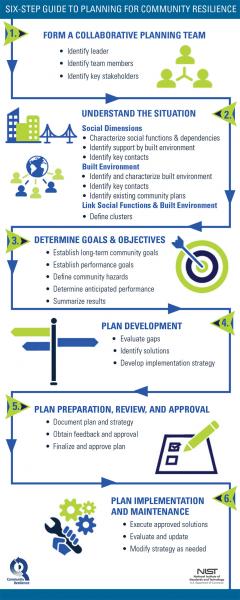Community Resilience
Some communities are well on their way to achieving community resilience. In general, they incorporate continuity planning, risk management, and long-term community resilience into all of their goals and public safety plans.
When these communities plan for hazard events, consider how to mitigate risk, and develop strategies for post-event recovery, they integrate the concept of resilience—the ability to bounce back from disruptions—in a proactive and continuous manner. For example, a resilient community's disaster preparedness plan doesn't only address preparedness. It also incorporates prevention, protection, mitigation, response, and/or recovery from natural or man-made hazards.
In contrast, some communities consider each of their plans in isolation. These communities may be able to improve their hazard resilience by engaging a broad set of stakeholders in more comprehensive, integrated, and purposeful planning.
Community resilience planning
Community resilience plans and actions do not take shape overnight—they are best undertaken as part of an inclusive, thoughtful, multi-step process. To help communities with this process, the National Institute of Standards and Technology (NIST) published the Community Resilience Planning Guide for Buildings and Infrastructure Systems. The guide describes a six-step planning process for building community resilience; the sequence of steps enables communities to improve their resilience over time in a way that is cost-effective and consistent with their development goals.
For planning, it's useful to consider three types of risks: routine hazards, design hazards, and extreme events. The different time horizons and levels of certainty associated with these risks have historically complicated efforts to integrate their planning. In general, many disaster plans are not well integrated with other community plans, such as comprehensive general plans, capital budgetary plans, or emergency operations plans. An integrated community-level resilience plan seamlessly incorporates steps for disaster preparedness and recovery actions with other community plans. This strategy can increase resilience—as well as efficiency—among administrative and executive units for service delivery and regulation.
When a community identifies resilience as a common goal across all of its planning efforts, the participants in the planning process may decide to add specific performance goals for buildings, infrastructure systems, or other community components. Developing these goals requires detailed input from a broad cross section of public and private leaders and stakeholders.
Integrating new systems into existing plans calls for understanding the community’s social, political, and economic systems, and a sense of how the systems are supported by the built environment. What are their vulnerabilities? How will damage to buildings and infrastructure systems impact community recovery? In order to address the resilience of buildings and infrastructure systems, planners need to understand structures’ exposure to prevalent hazards and their anticipated performance or possible improvement.
Defining community
The National Preparedness Goal developed by Federal Emergency Management Agency asserts that “individual and community preparedness is fundamental to our success.” In this case, community refers to a geographically bound location that functions within a governance structure—such as a town, city, or county.
Every community has its own identity based on location, history, leadership, population, and available resources. Successful communities provide their members with the means to meet essential needs and to pursue their interests and aspirations. Each community is subject to various natural and man-made hazards, and has its own level of risk tolerance. The most effective community resilience plans are customized to take all of these factors into account.
Stakeholder engagement
A committed planning team can provide the leadership it takes to engage the range of public, non-profit, and private stakeholders in a resilience-building process. In general, buildings and infrastructure systems—particularly those in the energy and communication sectors—are privately owned, so stakeholder collaboration is essential for broad-scale planning to be successful. As local government agencies are already responsible for implementing building codes, statutes, and community plans, they are the logical conveners to coordinate interests related to community resilience.
Many of the community resilience efforts that have been successful to date have been led by a community official who works with a resilience team. In this arrangement, a team identified by local government collaborates with other public, non-profit, and private entities. Working groups with representative stakeholders and subject matter experts develop recommendations.
A dedicated community resilience office—with a leading official who has supporting staff—can provide strong and consistent leadership. Every community has different capabilities and resources, though, and each should approach this process in a way that fits best within its style and means. In all cases, getting buy-in from community leadership and establishing and maintaining meaningful stakeholder engagement are vital to a sustained effort.
The preceding text is excerpted, edited, and abridged from the Community Resilience Planning Guide for Buildings and Infrastructure Systems, Volume 1.

